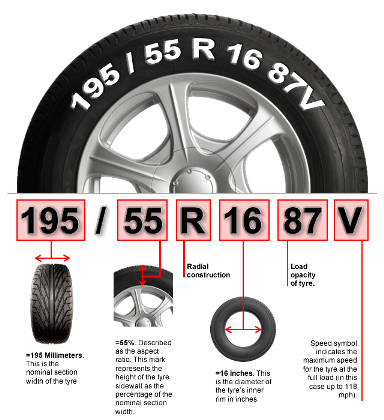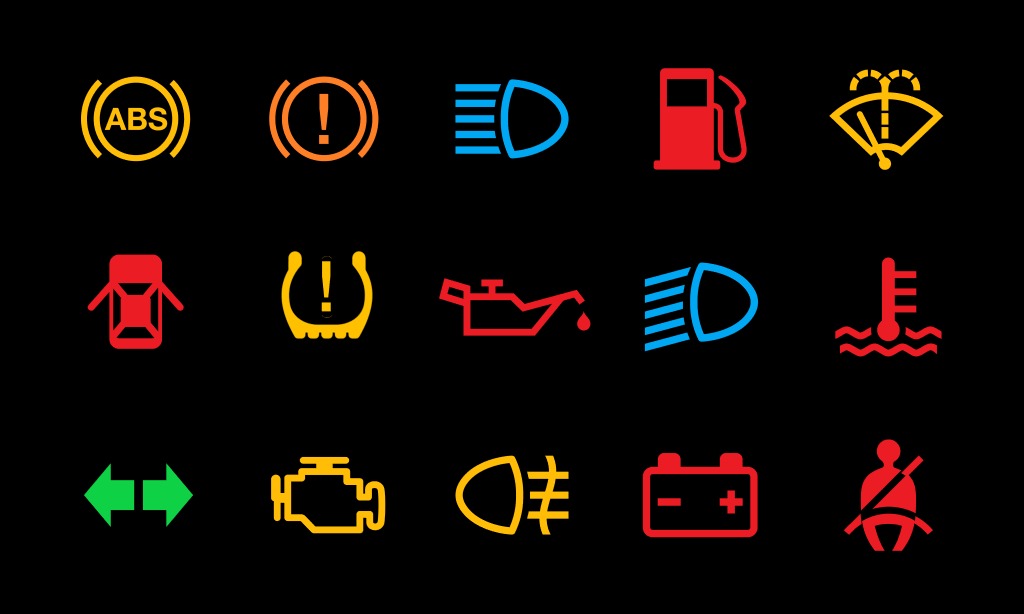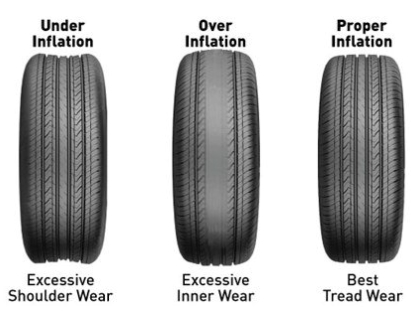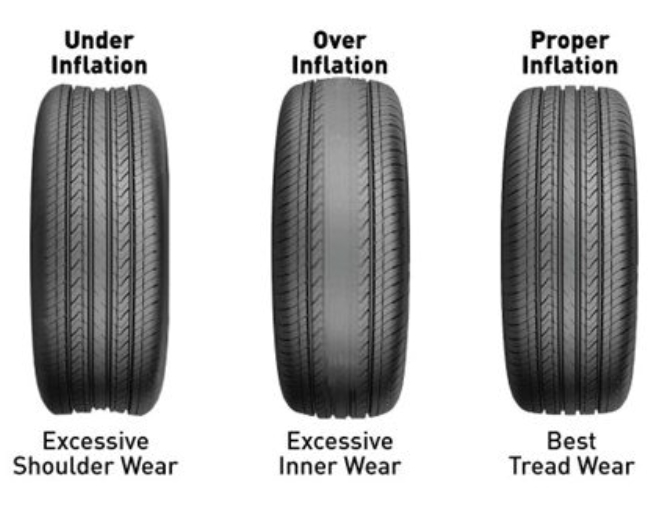Copyright © 2025, JOHN RID AUTOMOTIVE. All Rights Reserved.
•
25% too low tyre pressure increases
rolling resistance by 10% and fuel
consumption by 2%.
•
Too low tyre pressure also has
unfavourable effects on vehicle
handling and braking distance.
•
To ensure correct tyre pressure, you
need to check your car's tyres at
least once a month.
•
Tyre pressures must be checked
when the tyres are cold, this means
that you have driven less than three
kilometres, otherwise you have to
wait for about 10 minutes to let the
tyres cool down.
Tyre Pressures can save Fuel.

Side Wall Markings
•
On the sidewall of a tyre you will find
various codes and markings. Amongst
these you will find the size.
Tyre Sizes
•
Tyre sizes are made up of a number of
different numbers and letters.
•
195
The tyre section width in millimetres.
•
55
The aspect ratio in % ( the height of the sidewall divided by the tyre's width )
•
R
Denotes the tyre's construction type - in this case it's a radial Tyre.
•
16
Rim diameter in inches.
•
87
Load Index.
•
V
Speed Rating.
For example tyre size 195/55 R 16 87 V is made up of the following information.
Need help Identifying the size of tyres on your Vehicle.

Don't ignore Dashboard Warning Lights,
they could save you money.
Red Warning Lights are usually DANGER or Immediate Action
needs to be taken to prevent further damage to your Vehicle.
Amber Warning Lights are usually just a preventative reminder that
Oil, Tyre Pressures or Coolant needs topping up.
PETROL
E10 Unleaded or E5 Unleaded Premium
What’s the difference ?
Petrol: The most common fuel used to power cars in the UK,
unleaded petrol is mixed with bioethanol to make them more
environmentally friendly.
Diesel: Although UK demand has dropped due to some high
profile scandals and concerns over diesel’s environmental
impacts, common diesel types are regular diesel (low sulphur)
and premium diesel.
LPG: Standing for Liquefied Petroleum Gas, LPG is made of
butane and propane. It’s available at most UK fuel stations and is
cheaper than petrol and diesel, although cars need to be
specially converted to run on the gas.
Biofuels: Although not widely commercially available in the UK
on their own, biofuels are currently blended with both standard
unleaded petrol and standard diesel to make them more
environmentally friendly.
Electric: Increasingly common in the UK, battery electric
vehicles (BEVs) require no fuel whatsoever and are powered by
a rechargeable plug-in battery.
Hybrid: Powered by two distinct types of energy (either petrol or
diesel and electric), there are two types of hybrid car: plug-in
hybrid (PHEV) and hybrid.
What types of fuel are there in the UK?
There are six common ways to power your car in the UK:



What types of fuel are there in the UK?
There are six common ways to power your car in the UK:
Petrol: The most common fuel used to power cars in the UK, unleaded petrol is mixed with
bioethanol to make them more environmentally friendly
Diesel: Although UK demand has dropped due to some high profile scandals and concerns over
diesel’s environmental impacts, common diesel types are regular diesel (low sulphur) and
premium diesel†
LPG: Standing for Liquefied Petroleum Gas, LPG is made of butane and propane. It’s available
at most UK fuel stations and is cheaper than petrol and diesel, although cars need to be
specially converted to run on the gas
Biofuels: Although not widely commercially available in the UK on their own, biofuels are
currently blended with both standard unleaded petrol and standard diesel to make them more
environmentally friendly.
Electric: Increasingly common in the UK, battery electric vehicles (BEVs) require no fuel
whatsoever and are powered by a rechargeable plug-in battery
Hybrid: Powered by two distinct types of energy (either petrol or diesel and electric), there are
two types of hybrid car: plug-in hybrid (PHEV) and hybrid



Tyre Pressures can save Fuel.
•
25% too low tyre pressure increases rolling resistance by 10%
and fuel consumption by 2%.
•
Too low tyre pressure also has unfavourable effects on vehicle
handling and braking distance.
•
To ensure correct tyre pressure, you need to check your car's
tyres at least once a month.
•
Tyre pressures must be checked when the tyres are cold, this
means that you have driven less than three kilometres,
otherwise you have to wait for about 10 minutes to let the tyres
cool down.

Need help Identifying the size of tyres
on your Vehicle.
Side Wall Markings
On the sidewall of a tyre you will find various codes and
markings. Amongst these you will find the size.
Tyre Sizes
Tyre sizes are made up of a number of different
numbers and letters.
For example tyre size 195/55 R 16 87 V is made up of the
following information
•
195
The tyre section width in millimetres.
•
55
The aspect ratio in % ( the height of the sidewall
divided by the tyre's width )
•
R
Denotes the tyre's construction type - in this case
it's a radial Tyre.
•
16
Rim diameter in inches.
•
87
Load Index.
•
V
Speed Rating.

Red Warning Lights are usually DANGER or Immediate Action
needs to be taken to prevent further damage to your Vehicle.
Amber Warning Lights are usually just a preventative reminder
that Oil, Tyre Pressures or Coolant needs topping up.
Don't ignore Dashboard Warning Lights,
they could save you money.
PETROL
E10 Unleaded or E5 Unleaded Premium
What’s the difference ?
What types of fuel are there in the
UK?
There are six common ways to power your car in the UK:
Petrol: The most common fuel used to power cars in
the UK, unleaded petrol is mixed with bioethanol to
make them more environmentally friendly.
Diesel: Although UK demand has dropped due to some
high profile scandals and concerns over diesel’s
environmental impacts, common diesel types are regular
diesel (low sulphur) and premium diesel.
LPG: Standing for Liquefied Petroleum Gas, LPG is made
of butane and propane. It’s available at most UK fuel
stations and is cheaper than petrol and diesel, although
cars need to be specially converted to run on the gas.
Biofuels: Although not widely commercially available in
the UK on their own, biofuels are currently blended with
both standard unleaded petrol and standard diesel to
make them more environmentally friendly.
Electric: Increasingly common in the UK, battery
electric vehicles (BEVs) require no fuel whatsoever and
are powered by a rechargeable plug-in battery.
Hybrid: Powered by two distinct types of energy (either
petrol or diesel and electric), there are two types of
hybrid car: plug-in hybrid (PHEV) and hybrid
Copyright © 2025, JOHN RID AUTOMOTIVE. All Rights Reserved.





















